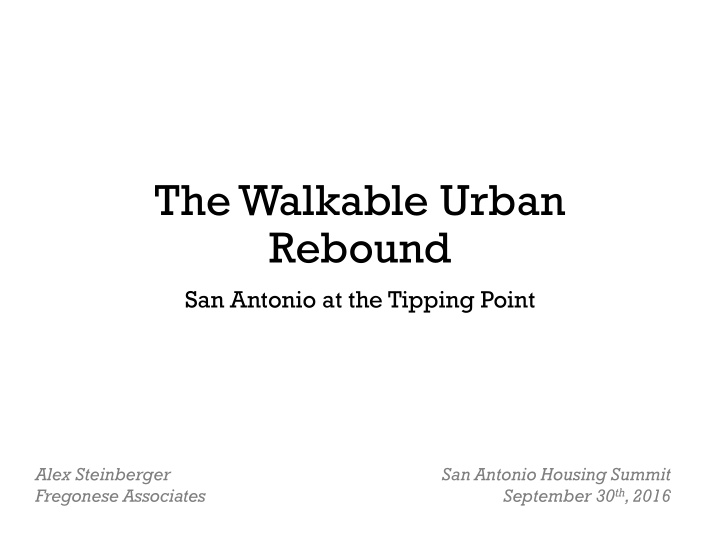



The Walkable Urban Rebound San Antonio at the Tipping Point Alex Steinberger San Antonio Housing Summit Fregonese Associates September 30 th , 2016
The (Walkable) Urban Rebound “Walkable urbanism development is now propelling real estate growth in office, retail, and multi-family rental product types from a rental premium and absorption basis in the largest 30 U.S. metros.” - Foot Traffic Ahead: Ranking Walkable Urbanism in America’s Largest Metros, 2016
Walkable Urban Driveable Suburban
Drivable Suburban • Historically low-density development (generally 0.05 to 0.4 floor area ratio or FAR) • Segregated real-estate product types (different real estate product types generally separated from one another) • Standardized product types that, aside from superficial architecture, are similar throughout the country • Cars and trucks as the predominant transportation mode. This is often called SPRAWL…
Walkable Urban Development • Substantially higher densities (1.0 to 40 FAR, though mostly in the 1.0 to 4.0 range) • Mixed-use real-estate products, or the adjacent spatial mix of products • Emerging “new” product types, such as rental apartments over a ground-floor grocery store • Multiple transportation options, such as bus, rail, bicycle, and pedestrian-friendly sidewalks, as well as motor vehicles, that connect to the greater metro area. We call these Walkable Urban Places or “ WalkUPs ” for short…
Urban Form in San Antonio
Investment in San Antonio
Superimposed
“Incentivize transit supportive development opportunities and incorporate transit supportive infrastructure improvements to promote transit use.” “Continue to focus on the revitalization of neighborhoods adjacent to downtown and extend these efforts to regional centers, urban centers and transit corridors.” “Work with VIA Metropolitan Transit to develop a long-term transit plan that facilitates transit-supportive development.”
Where are we now? In large metros, investment is starting to shift from “ driveable suburban” to “walkable urban” San Antonio is starting to experience this shift, but not to the same degree as peer metros. Recent planning efforts align with this market shift and may hasten its arrival.
San Antonio at a Tipping Point
Urban Amenities Can Be Catalysts for Redevelopment Parks and Open • Space • Transit Commercial • Amenities • Traffic Calming Walkability • Bicycle • Connectivity
Feasibility Curve Close-in WalkUPs
FROM DRIVEABLE SUBURBAN
TO WALKABLE URBAN
Austin
Denver
Portland
Psychographics WHO LIVES HERE NOW?
San Antonio Blended Psychographics Established Families and Young and Diverse Boomers Families Millennials Hardworking Households
Established Families and Boomers Baby Boomers (46-64) will constitute a senior population unprecedented in size. They will look for homes where they can age-in-place. Hardworking Households These are disproportionately older and predominantly single family households with moderate education and lower paying jobs who are deeply connected to their communities.
Millennials Millennials (Gen Y) may rent far longer than previous generations. They prefer walkable, urban neighborhoods. Young Diverse Families San Antonio will continue to be a majority minority region. These households will seek homeownership and may be willing to move in order to achieve it.
Young, Diverse Families in San Antonio
Urban Form in San Antonio
Superimposed: Urban Form
Superimposed: Investment
Where are we headed? San Antonio has a lot of neighborhoods that could become WalkUPs . The resulting investments could make housing and commercial space more expensive . Residents of these neighborhoods may be vulnerable to displacement .
Tools to Target Policies Buildable Acres ◊ Transit Access to Low Wage Jobs Affordable Housing Vulnerability Development Pressure 6.1 3.5 9.3 9.9 8.0 1.8 8.0 6.0 5.4 2.8 1.5 6.4 8.5 10.0 4.6 8.4 6.9 4.0 3.4 3.2 0.4 6.0 4.4 4.9 10.0 7.1 9.6 6.5 6.2 10.0 5.9 4.4 9.9 4.5 6.7 7.6
Setting Housing Targets
Psychographics Corridor Psychographics VIA Vision 2040 Routes 100% 90% 80% 70% 60% 50% 40% 30% 20% 10% 0% Urban Millenials Established Families Young Diverse Hardworking
The Corridor Housing Preservation Index: A new tool for equitable corridor planning
Transit Access to Low Wage Jobs 100% 10 80% 8 60% 6 40% 4 20% 2 0% 0 Young Diverse Families Transit Access to Low Wage Jobs
Affordable Housing Vulnerability 100% 10 80% 8 60% 6 40% 4 20% 2 0% 0 Young Diverse Families Affordable Housing Vulnerability
Development Pressure 100% 10 80% 8 60% 6 40% 4 20% 2 0% 0 Young Diverse Families Development Pressure
What can we do? The City and VIA are planning for equitable growth around transit. As we make big capital investments, we should be conscious of the real estate impacts . We can use analytical tools to understand, track, and target our efforts for the greatest benefit to vulnerable residents .
“When you start revitalizing communities, a real estate effect takes hold…” “What is important for the public sector to understand, is they need to work with communities to create ‘ place-holders ’ so that when the economic cycle takes hold, you can maintain places for people who were the backbone behind the change.” -Jeana Wolley, Portland Area Developer
Recommend
More recommend